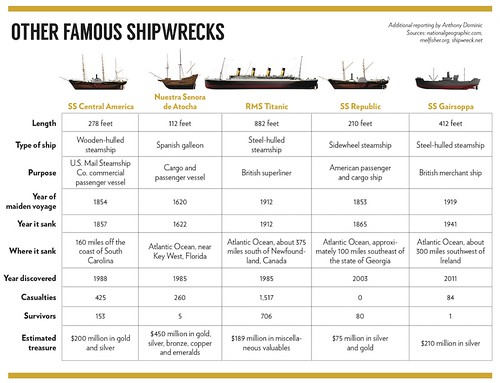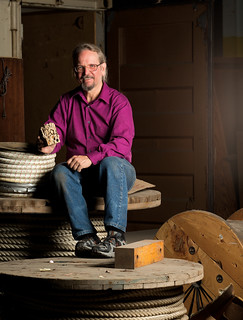
PREV ARTICLE
NEXT ARTICLE
FULL ISSUE
PREV FULL ISSUE
SS CENTRAL AMERICA SALVAGE: THEN AND NOWColumbus Monthly magazine published a great article on the history of the
SS Central America salvage operations. It's lengthy and well worth a read. Here are a couple of
excerpts. -Editor
 Finding the Wreck: 1989
This didn’t sit well with Evans. The site was in a high-probability zone. It was one of the more promising sites they had found. If it was the Central America, there should be gold. Something wasn’t right. So, Evans spent the off season—the winter months of 1987 into 1988—reviewing all the images the sonar scanner produced the first summer at sea, paying particular attention to the images that weren’t included in the Hit Parade. What he found was an image of what appeared to be piles of coal, forming a shape that roughly matched the size of the Central America—better than the other image did, anyway. Though it had been written off as a geological mass, Evans had a nagging feeling this might just be the Central America. If he was right, they had wasted an entire summer and millions of dollars exploring the wrong site. When the group geared up for the next season, Evans told Thompson and Williamson about what he’d found. It was in a low-probability area but en route to the original site, so they decided they might as well pass over it. The crew, fresh from the off season and prepared for another summer at sea, arrived at the site of the mass that piqued Evans’ curiosity in their newly renovated research vessel, the Arctic Discover. When they dropped Nemo, nobody expected what happened next. Almost immediately, from the corner of the screen, an image of a large iron sidewheel began to creep into view. The room erupted. Shouts of “Whoa!” and “Oh my God!” echoed throughout the control room. Awestruck, Nemo’s operator John Moore began to proclaim, “You know…” and, in unison, the entire crew finished, “what that is!” Moments later, Nemo was inches from crashing into a mast extending straight up into the water. On their first dive of the season, they had hit the target dead center. Bob Evans Returns: 2014
Unlike the rest of the Explorer crew, 60-year-old Evans is not embarking on this journey for the first time. This is a homecoming. He’s been to the Central America, explored the caverns of its decay, seen artifacts frozen in time, marveled at colonies of sea creatures growing on castles of gold and held the precious metal when it was hauled to the surface. He’s heading back to the site to finish what he and a team of other scientists, oceanographers and treasure hunters started 25 years ago but never completed. He’s going back to finish the story. “I am thrilled to be going back to this shipwreck,” he says. “Absolutely thrilled. This has been a project that I have worked on and dreamed about and studied in great detail for 30 years. This is a dream come true.” When Evans left Charleston in April, the trees were just beginning to bloom. Their leaves were already changing color and falling off by the time he returned in September. He had worked the night shift on the Odyssey Explorer—9 p.m. to 9 a.m.—and saw more of the moon than the sun. Still, his fair skin was red and raw as he recounted his summer at sea during an interview in September. Ironically, he wasn’t sunburned while he was on a ship in the middle of the ocean. Rather, it happened the first day he was back on his farm in Muskingum County, mowing the fields, cutting down a maple tree, tending to the horses and sheep and chickens. Evans is spry for 60—heck, he’s spry for 50—and he didn’t stay idle for long, despite his arduous summer. Though work at sea is demanding, returning to the site of the Central America was a delight for Evans. It was the opportunity to finish what he started—an opportunity he never thought he’d have again. “I had given up hope that this would happen,” he says, his voice thick with emotion. “It has been very fulfilling.” Finally, after more than 20 years, he was able to see what had become of his experiments. He holds up a small block of wood—jagged on its sides and nearly hollowed out with cylindrical holes. This is what remains of the pine 4-by-4 they planted in the sediment in 1990. It was 3 feet tall then; now, it’s no taller than 6 inches. The round tunnels were carved by shipworms, which are actually a species of clam, like the ones that consumed the entire ship. Judging by the state of the experimental piece of wood, it didn’t take them very long. The shipwreck is not only scientifically significant. It’s culturally significant. It is a time capsule, a period snapshot. Over the summer, the Odyssey Explorer crew found thousands of artifacts buried in the sand. A clay pipe, a miniature chess piece. A ladies comb, a spoon. They even found parts of a music box. Evans, a pianist, plans to use the impressions in the drum to decipher the tune it once played. Most telling were the photographs. Portraits of young women, of husbands and wives, of mothers and their children. Lifeless but preserved. They are the loved ones of passengers aboard the ship’s final voyage. They are the survivors. They are the victims. “To see people’s faces staring up at you from the bottom of the sea, it’s startling,” he says. “Talk about humanizing what it is that you’re working on.” To read the complete article, see:
 Wayne Homren, Editor The Numismatic Bibliomania Society is a non-profit organization promoting numismatic literature. See our web site at coinbooks.org. To submit items for publication in The E-Sylum, write to the Editor at this address: whomren@gmail.com To subscribe go to: https://my.binhost.com/lists/listinfo/esylum All Rights Reserved. NBS Home Page Contact the NBS webmaster 
|
